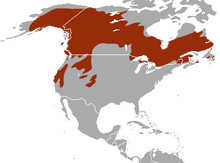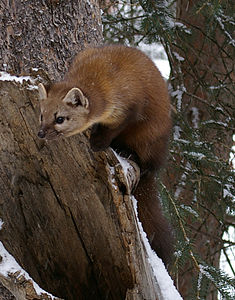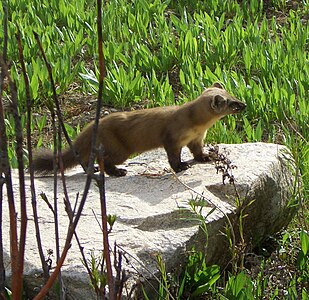Spruce marten
| Spruce marten | ||||||||||||
|---|---|---|---|---|---|---|---|---|---|---|---|---|

Spruce marten ( Martes americana ) |
||||||||||||
| Systematics | ||||||||||||
|
||||||||||||
| Scientific name | ||||||||||||
| Martes americana | ||||||||||||
| ( Turton , 1806) |
The spruce marten ( Martes americana ) is a species of predator from the genus of the real marten that is widespread in North America . It looks very similar to the European pine marten and is sometimes viewed as a subspecies thereof.
features
As with most martens, the body of the spruce marten is elongated and slender, the limbs are short. The fur is predominantly brown in color, the head is gray, the legs and tail are dark brown or black. Like the pine marten, it has a yellow throat patch, but is significantly smaller and more delicate than this. Males reach a head body length of 36 to 45 centimeters, the bushy tail becomes 20 to 23 centimeters long and the weight is 0.47 to 1.25 kilograms. They are on average 65% heavier than the females, who reach a weight of 0.28 to 0.85 kilograms, have a head body length of 32 to 40 centimeters and a tail length of 18 to 20 centimeters.
Tooth formula: I 3/3, C 1/1, P 4/4, M 1/2 = 38.
distribution and habitat
Spruce martens are native to North America, their range includes large parts of Alaska and Canada with the exception of the far north. In the United States , they are common in the Rocky Mountains , Great Lakes region, and New England . Their habitat is mainly coniferous forests.
Way of life
Spruce martens are primarily nocturnal. During the day they retreat into hollow tree trunks, crevices in the rock or abandoned burrows of other animals in order to search for food at night. They can be found both in the trees and on the ground, and they can swim and dive very well. They don't hibernate .
Like most martens, they are territorial. The average area size is 8.1 square kilometers for males and 2.3 square kilometers for females, but it can vary significantly depending on the habitat and food supply. Specimens released by humans also usually remain near the place of their release for a few years. However, individual animals also migrate, for example a male marten covered 80 kilometers after being released in March and the following November. It is reported from Alaska that the martens tend to go to higher elevations in the spring and come down again in the fall. They live mainly solitary, but sometimes a male and female can be observed together.
food
Spruce martens are omnivores , although small mammals such as rodents make up the main component of the diet. They also eat birds , insects , carrion and fruits.
Reproduction
Mating takes place in midsummer between June and August, but due to a dormancy the fertilized egg does not implant until February. The actual gestation period lasts around a month, and in March or April the female gives birth to one to five (average 2.6) young. These open their eyes at 40 days, are weaned at six weeks and are fully grown at 3.5 months. Sexual maturity occurs in the second year of life. Life expectancy in the wild is up to twelve years, in captivity up to 17.
Systematics and taxonomy
The spruce marten was first scientifically described in 1806 by the English naturalist William Turton . Numerous subspecies have been described, eight of which are recognized in the Handbook of the Mammals of the World . Outwardly, the subspecies can hardly be distinguished. However, with the help of DNA comparisons, it was found that the spruce marten consists of two clades, one of which is congruent with the subspecies Martes americana caurina that occurs on the Pacific coast . Since the latter hybridizes only slightly with the other spruce martens in the contact zone, it was recognized as an independent species.
Danger
Because it was hunted by trappers because of its valuable spruce sable fur , the spruce marten has become rare in large parts of its range. In New England and Michigan it was completely eradicated at times, but has since been successfully reintroduced. Today it is regionally protected, but due to its frequency, especially in the sparsely populated north of Canada, it is not considered to be threatened globally.
and in Grand Teton National Park
literature
- Ronald M. Nowak: Walker's Mammals of the World . Johns Hopkins University Press, 1999 ISBN 0-8018-5789-9
supporting documents
- ↑ a b c Serge Larivière & Andrew P. Jennings: Family Mustelidae (Weasels and relatives). in Don E. Wilson , Russell A. Mittermeier : Handbook of the Mammals of the World - Volume 1 Carnivores. Lynx Editions, 2009, ISBN 978-84-96553-49-1 . Page 628.
- ^ A b Milan Novak et al., Ministry of Natural Resources: Wild furbearer management and conservation in North America . Ontario 1987, Chapter 41, pp. 537, 542 (English). ISBN 0-7778-6086-4
- ^ Pacific Marten page of the American Society of Mammalogists
- ↑ Maureen P. Small, Karen D. Stone et al. Joseph A. Cook: American marten (Martes americana) in the Pacific Northwest: Population differentiation across a landscape fragmented in time and space. Molecular Ecology 12 (1): 89-103 February 2003, DOI: 10.1046 / j.1365-294X.2003.01720.x
Web links
- Martes americana in the endangered Red List species the IUCN 2006. Posted by: Mustelid Specialist Group, 1996. Retrieved on 12 May, 2006.
- Spruce sable skin




